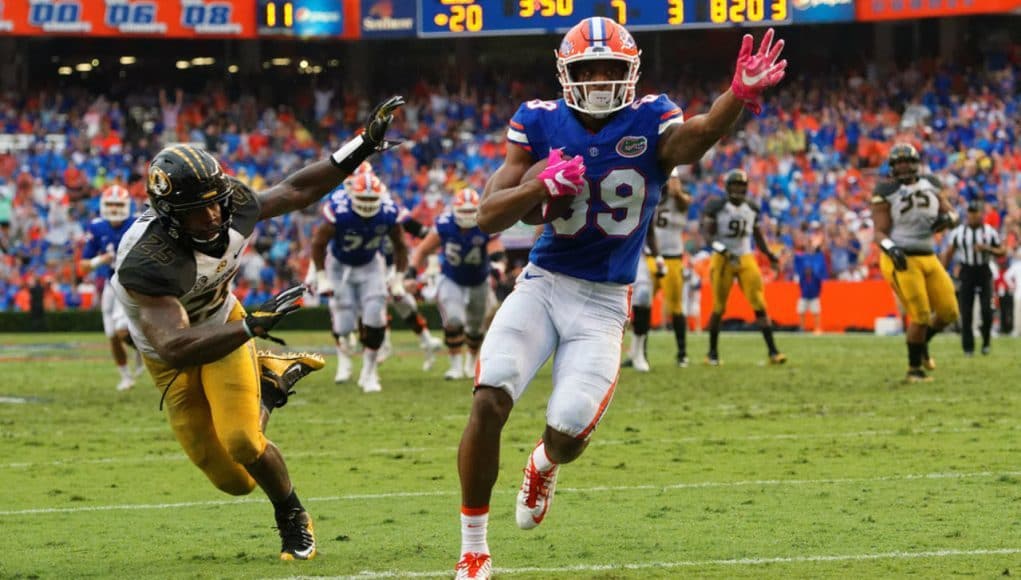There are a couple of old videos on YouTube of University of Utah quarterbacks coach Dan Mullen explaining the take on the spread offense that he helped implement under head coach Urban Meyer. They are an interesting time capsule both for that era — Mullen is diagramming plays on a whiteboard on top of a projection from a Windows XP computer — and for a time when a lot of general football fans didn’t yet understand this newfangled “spread offense”.
Mullen describes an unsustainably pure vision of what the offense was. “The basis of the spread offense,” he says, “is an option attack that gives the deception that we are a very pass-oriented team by spreading the field from sideline to sideline with multiple sets of three, four, and five wide receivers.” It was an offense with running backs, receivers, and pass-catching and run-blocking tight ends.
When he and Meyer arrived at Florida, they moved the team’s fullbacks to linebacker. You can still see Billy Latsko and Eric Rutledge listed as such on the 2005 roster. According to Meyer’s old authorized biography Urban’s Way, Meyer, Mullen, and Steve Addazio met right after the ’05 LSU loss and retooled the offense to include fullbacks, tight ends blocking on pass plays, and fewer four and five-wide sets.
I found the 2005 Alabama loss on YouTube to see what the pre-overhaul offense was like — I don’t recommend this, by the way — and saw a multitude of four and five-wide sets and a few run plays with Latsko and Tate Casey as blockers. Sure enough though, those two never blocked on a single pass play. They blocked on runs and ran patterns on passes. The only time Casey lined up next to a tackle and blocked was on a designed quarterback draw for Josh Portis.
So, those videos are interesting historically and something to make Mullen cringe, whether for his monotone delivery or pleated khaki pants. The philosophy in them does still remain to this day in one important respect.
Mullen repeats over and over that the purpose of spreading out the defense is to make it defend the entire width of the field. In the passing video, he lets on that it’s not just horizontal space that matters. “As well as having a quick passing attack,” he explains, “you need a down-the-field vertical passing attack so that the defense cannot sit on you when you’re trying to throw the ball, and again forcing them to cover not only the entire width but the depth of the field as well.”
The 2005 team never really had a shot at running the offense at a high level because it just didn’t have enough at receiver. Chad Jackson had 88 catches and Dallas Baker had 52, but no one else had even 30. Bubba Caldwell went down for the season after three games, and Jemalle Cornelius and Jackson battled injury at times. The 2006 team, by comparison, had five guys with at least 30 catches, with the fleet boosted by Cornelius Ingram’s move to tight end and the arrival of Percy Harvin.
The offense took off in 2007 with Tim Tebow ascending to the quarterback spot, but that team also had a pair of quality deep threats in Caldwell and Harvin. Harvin and Louis Murphy could go long in 2008, and Riley Cooper was that guy in 2009. The ’09 offense didn’t work at as high a level, though, because it lacked quality depth at the receiver position. At receiver the Meyer/Mullen spread offense must have both quality depth, to force the defense to cover the entire field horizontally, and at least one true deep threat, to force the defense to cover the entire field vertically as well.
The pattern has continued for Meyer at Ohio State. It’s no coincidence that his first three offenses in Columbus were terrific with Devin Smith as his deep threat. Smith average an eye-popping 28.2 yards per catch in the national title campaign of 2014. The offense then regressed a bit the next two years without him before returning to form in 2017 with Johnny Dixon averaging 23.4 yards per catch.
It held for Mullen at Mississippi State as well. His three best offenses as rated by S&P+ were also his only three with a receiver that averaged more than 16 yards per catch on more than 15 receptions on the season.
All of this is to say that Tyrie Cleveland is the single most important player to the 2018 Florida offense aside from the quarterback. Cleveland has proven himself to be a true deep threat, putting up 21.3 yards per catch on 14 receptions in 2016 and 18.6 yards per grab on 22 receptions last year. He must prove himself to be more than that to progress as a player as he hits his upperclassman years, but he really is a guy who can force the defense to cover the entire field vertically.
I think UF may have the quality depth to force the defense to cover the field horizontally, especially if Trevon Grimes and/or Van Jefferson are cleared to play right away. Kadarius Toney has the ability to be magical in this offense from the slot. Josh Hammond and Freddie Swain can be reliable possession receivers with some better coaching to clean things up. Dre Massey is fast, while signees Jacob Copeland and Justin Watkins have very impressive high school tape.
The horizontal is only half of the equation, though. The vertical must also be there, and that’s what Cleveland does. The philosophy and history are clear: the offense that Mullen runs can’t hit its peak potential without a true deep threat. Whether Cleveland can stay healthy and keep his past form will determine where the ceiling of the 2018 Florida offense will be.


